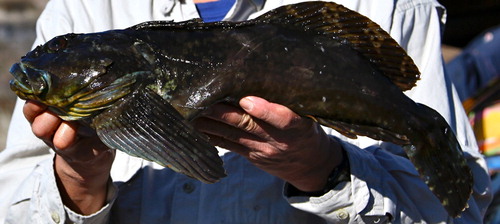To the Editor:
Cabezon, Scorpaenichthys marmoratus, is a member of the Cottidae (sculpin) family. Its flesh is safe for consumption. However, the roe are known to contain a phospholipid ichthyotoxin.Citation1 Human effects regarding ingestion of cabezon roe and its ichthyotoxin are not well reported.
A couple, aged 62 and 64 years, developed gastrointestinal toxicity after ingesting the flesh and roe of a 6-pound greenish-colored, scaleless cabezon caught off the coast of Northern California (). The both fresh fish filets and approximately 0.5 cup of roe stored with uninterrupted refrigeration were poached separately in barely boiling water and consumed together.
Both patients had a virtually identical onset of symptoms and course. A few hours after ingestion, they developed abrupt onset diaphoresis, chills, abdominal pain and cramping, with nausea and vomiting followed by voluminous, non-bloody diarrhea throughout the night. They each detailed several pounds of fluid loss based on daily body weights. The symptoms abated in both after approximately eight hours.
The following morning, both were seen in the emergency department. The 62-year-old healthy female had normal vital signs aside from a pulse of 100 beats per minute. Physical exam was otherwise unremarkable. Basic laboratory evaluation including comprehensive metabolic panel, cell blood count, lipase, and lactic acid were normal aside from mild hyperglycemia (116 mg/dL) and a mild leukocytosis of 10.1 K/uL with 92% neutrophils. The 64-year-old male, also healthy aside from hypertension had normal vital signs upon arrival and similar laboratory screening was within normal limits aside from mild hyperglycemia (108 mg/dL). There is no standard available to identify or quantify the toxin in serum or other body fluids. Both patients were discharged after hydration and a brief observation period. Neither developed any neurologic effects such as headache, paresthesia, vertigo, or ataxia. Follow-up via telephone the next day and one week later revealed both were feeling well.
There is scant information reported in the modern medical literature regarding the toxicity of cabezon roe. This ichthyotoxin is thought to be similar or identical to dinogunellin, found in the poisonous roe of another marine fish, the northern blenny.Citation2 There is a report of a couple that experienced chills and fever, vomiting and diarrhea four hours after ingesting roe from a cabezon in 1923.Citation3 Halstead reports similar symptoms with roe ingestion as well as rapid irregular pulse, syncope, chest pain, pallor, tinnitus, and even death from ingestion in which he mostly cites non-English sources from the 19th and early 20th century.Citation4 Illness and death in both mice and guinea pigs fed ground up cabezon roe has been demonstrated.Citation3 Previous animal studies have also shown lethality in mice when purified poison was injected intraperitoneally. There are no known antidotes and the toxin is thought to be non-dialyzable.Citation1 This case uniquely demonstrates the seldom-reported human toxicity of cabezon roe ingestion.
Declaration of interest
The authors report no declarations of interest. The authors alone are responsible for the content and writing of the paper.
References
- Furhman FA, Furhman GJ, Roseen JS. Toxic effects produced by the extracts of eggs of cabezon Scorpaenichthys marmoratus. Toxicon 1970; 8:55–61.
- Hashimoto Y, Kawasaki M. Occurrence of toxic phospholipid in cabezon roe. Toxicon 1976; 14:141–143.
- Hubbs CL, Wick AN. Toxicity of the roe of the cabezon, Scorpaenichthys marmoratus. Calif Fish Game 1951; 37:195.
- Halstead BW. Fish poisonings – their diagnosis, pharmacology, and treatment. Clin Pharmacol Ther 1956; 5:615–627.


